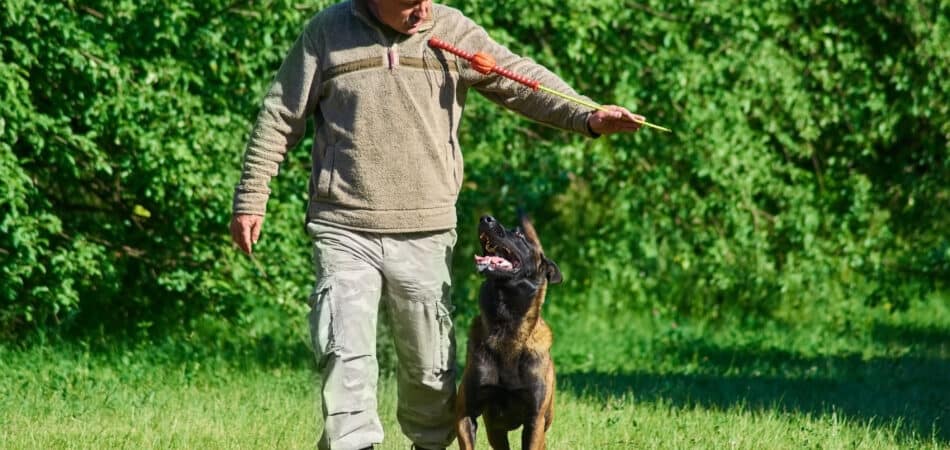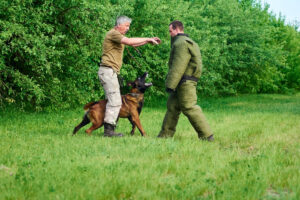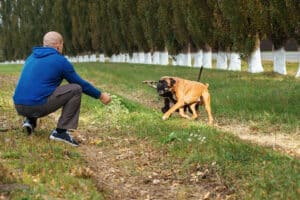






There’s a pervasive idea right now that genetics and the right breed trumps training protection dogs—that if you just raise them right, everything will be fine.
(And don’t get me started on what a lot of “raising them right” constitutes these days, starting with inappropriate and downright harmful “socialization.”)
Guess what? That’s not how it works.
Professional training is a function of expertise, experience, and a deep understanding of canine behavior. And you can’t DIY your way to a reliable, balanced protection dog using YouTube tutorials or TikTok tips.
Protection dogs operate in high-stakes scenarios. They need precision in every move, confidence under pressure, and clarity in how they interpret your commands.
None of these qualities come pre-installed in any breed—they’re cultivated through deliberate, professional training.
And that’s where the right protection dog trainer comes in—not just any trainer, but one with the skill to transform raw potential into reliable, situational responses.
But here’s the rub: not just any trainer will do. So, how do you pick the right one?
Let’s break it down.
 First and foremost, you need a trainer who specializes in protection dog training—not someone who dabbles in every type of working dog.
First and foremost, you need a trainer who specializes in protection dog training—not someone who dabbles in every type of working dog.
When I see trainers claim they can handle everything from sports to service to protection, I can’t help but question how they manage to deliver consistent, high-quality results across such a wide range of disciplines.
Specialized training is not a “jack of all trades” scenario—it requires focus, precision, and a deep understanding of protection work specifically.
Now that we’ve set the record straight on the importance of specialization, let’s dive into what else you should look for in a trainer:
Let’s start with the basics: formal training and certifications. A protection dog trainer should have a proven background, ideally with credentials from recognized organizations like the International Association of Canine Professionals (IACP), the National Association of Dog Obedience Instructors (NADOI) or similar organizations.
However, a piece of paper alone doesn’t mean much without real-world experience. The best trainers combine formal education with hands-on expertise, often accrued over years of working with different breeds, and training scenarios.
If they’ve worked with law enforcement or military canine units, that’s even better—it signals that they understand the high level of discipline and skill these dogs require.
What you don’t want is someone who’s only dabbled in training or learned via YouTube tutorials. Protection work is a specialized field, and trusting an amateur could end in disaster—for you and your dog.
Trendy dog training methods pop up all the time. You’ve probably heard phrases like “positive-only reinforcement” or “balanced training.”
While it’s good to understand these terms, don’t let flashy jargon overshadow what really matters: experience.
Ask potential trainers how long they’ve been working with protection dogs specifically. Have they successfully trained dogs for real-world applications, or is their experience limited to theory and controlled environments? A seasoned trainer will have stories, examples, and proof of success.
Look for evidence. Can they demonstrate a dog they’ve trained? Do they have references? Better yet, ask to speak directly with past clients. Hearing firsthand about their methods, communication style, and professionalism can be a game-changer.
This isn’t the time to take anyone’s word for it—proof is non-negotiable.
Every dog is different. A good trainer will recognize that and offer customized training programs designed to your dog’s breed, age, temperament, current skill, and intended role.
For instance, a German Shepherd with strong prey drive might require different techniques than a more defensive Cane Corso. Likewise, a young pup will need foundational training before tackling advanced protection work.
Plus, training a dog for family protection differs significantly from preparing one for law enforcement. A trainer worth their salt will tailor the program to maximize your dog’s potential.

Pay attention to how they handle challenges. Are they patient yet firm? Do they adapt their approach if something isn’t working?
Trainers who rely on intimidation or aggression are red flags—protection work is about building confidence, not fear.
Bonus tip: Watch how the dogs respond. A well-trained protection dog should display focus, engagement, and calm assertiveness. If the dogs seem anxious, overly submissive, or erratic, it’s a sign that something’s off.
A skilled trainer isn’t just good with dogs—they’re also good with people. Clear, consistent communication is critical for ensuring you and your trainer are on the same page.
They should explain the training plan, provide regular progress updates, and be available to address your questions or concerns. A trainer who’s difficult to reach or dismissive of your input is not the right fit.
If a trainer makes you feel intimidated, belittled, or confused, move on. The relationship between you, your dog, and the trainer is a partnership. Everyone needs to be on the same page to ensure success.
Pay attention to where the training takes place. A well-equipped training facility can be a sign of a professional operation.
Look for clean, safe, and appropriately sized spaces that allow for both controlled exercises and real-world simulations.
Ideally, the trainer should expose your dog to various environments—homes, streets, parks, and even crowded areas—to ensure they’re prepared for any situation.
This type of environmental conditioning is essential for building a confident, adaptable protection dog.
A great trainer understands that the relationship between you and your dog is the foundation of effective protection work. That’s why they’ll actively involve you in the training process.
Look for a trainer who emphasizes handler education. They should teach you how to communicate with your dog, read their body language, and reinforce the training at home.
They’ll also guide you on how to handle your dog to avoid liability issues.
After all, the trainer won’t always be there. You need to feel confident and competent in managing your dog in real-world scenarios.
Be wary of trainers who guarantee specific outcomes, especially within unrealistically short timeframes.
Statements like, “I can make any dog fully protection-ready in two weeks,” should set off alarm bells.
Effective training takes time, consistency, and patience. While it’s reasonable to expect progress in stages, promising perfection is a red flag. Trust the trainers who give you a realistic roadmap, not the ones who try to sell you shortcuts.
Training doesn’t stop once the sessions are over. Your dog will need ongoing reinforcement to maintain their skills and behavior.
Look for a trainer who offers post-training support, whether it’s follow-up sessions, refresher courses, or access to resources that help you continue the training at home.
People come to me all the time saying, “I don’t understand why my dog isn’t responding. The trainer said they were doing great, but now it’s like we’re back to square one.”
The thing is: a lot of trainers are great at selling results but not delivering sustainable ones. They either rush the process, focus on surface-level obedience, or fail to address the deeper behavioral foundations that make protection work reliable.
So, here are some red flags to watch out for:

Protection dogs need to be bred, raised, and trained appropriately from the beginning. Turning a puppy into an elite protector can take up to 3 years or even longer, depending on the dog’s individual characteristics and the specific goals of the training.
A common issue in the industry involves people purchasing dogs advertised as “fully trained” for protection purposes, only to discover they’re not truly trained—or trained inappropriately—for real-world scenarios.
These new owners often have no clue how to work with or live alongside a protection dog (especially if the dog starts displaying unwanted behaviors), leading to confusion and frustration on both ends.
When they bring these dogs to us for retraining, the process can take 6-12 months or more. This is because we need to address and correct any inappropriate training methods or behavioral issues before building proper protection skills.
Moreover, protection dogs require regular maintenance training throughout their working lives. Refresher courses typically run for 2-4 weeks annually and serve several important purposes:
Now, I see people who purchase a breed solely because of its size and decide to attempt protection training without proper knowledge or experience.
This approach often leads to behavioral issues and can even be dangerous for both the dog and the owner. Protection work requires careful selection of dogs with the right temperament, proper socialization, and systematic training by experienced professionals.
So…..

It’s worth every penny to work with someone who understands breeds, bloodlines, and the various levels of protection training required to create a reliable and balanced dog.
At Vanguard, we specialize in modern tactics and practical street applications. Our training goes beyond equipment fixation to ensure the dog’s skills are functional and reliable in real-world scenarios.
For instance, we teach practical handling techniques that prioritize safety and control, both for the handler and the dog.
We focus on isolating and activating the correct drives needed for success—whether it’s prey drive, defense drive, or a balanced combination—while ensuring those drives are managed properly to prevent undesirable behaviors.
One of our core principles is that a protection dog must always recall instantly and release (or “out”) immediately on command—no hesitation.
Now, we offer different training packages tailored to meet your needs, whether you’re starting with a puppy, a young adult, or an older dog requiring specialized work.
Each training package includes complimentary lifetime support, so you’re never left without guidance.
Your peace of mind starts here.
Now, if you’re ready to find the perfect trainer for your protection dog, it’s time to stop waiting and start acting.
Contact us today for a free consultation and take the first step toward a safer, more secure future.